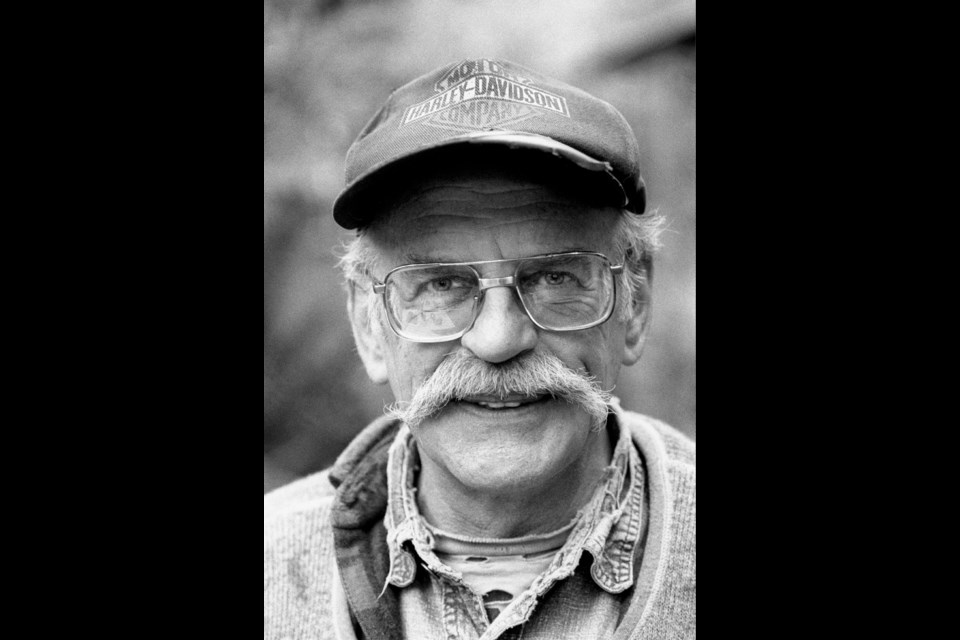 Jan Johnson died in 2011, but as his widow, Mary Alice Johnson, told me: “After someone dies, you still have this growing relationship with them. So, I’m still learning.”
Jan Johnson died in 2011, but as his widow, Mary Alice Johnson, told me: “After someone dies, you still have this growing relationship with them. So, I’m still learning.”
I’d say we all have a lot to learn from Jan Johnson, a sculptor who was one of the legendary characters of Sooke. Mary Alice, with curator Brianna Shambrook, has put together Tales of Woe and Whimsy, a packed little retrospective of his work at the Sooke Region Museum.
Johnson’s sculptures include a gladiatorial combat, taking place in a miniature amphitheatre made of a tractor seat. They first appeared at the Fran Willis Gallery, then Eclectic Gallery and the (now-defunct) Collective Works in Fernwood. He was in every one of the Sooke Fine Art annuals while he was alive.
Typically, he started with bits of cast-off metal junk, and populated them with hordes of little figures playing out scenes from the Bible, the Mahabarata, Dante and the Greek myths. Made of springs and nails, spikes and sheet metal, these sculptures were small in scale — table-top size — but huge with dramatic intensity. They sold readily, but that really wasn’t the point.
Johnson was a well-balanced mixture of extremes. To all appearances he was a “good old boy” who scrounged for materials in industrial scrap heaps while living with his wife in a hand-built house off Otter Point Road. But he supported his artistry working for the World Bank and the Asian Development Bank as a transportation economist, doing studies all over the world.
With degrees in economics and engineering, Johnson was also hugely well-read in Islamic and Hindu myth — and everything else. The engineer and the artist: He brought them together.
Born in 1943, Johnson grew up in the harsh setting of a ranch in Hulett, Wyoming, near the Devil’s Tower. One day, his beloved older brother went off to university and was killed in a car crash on the way.
“All the joy went out of the family,” Mary Alice told me. Eleven-year old Jan was sent to a Christian boarding school with a strong military bent. He later joined the Reserve Officer Training Corps to pay for university, with the result that he was among the first American soldiers sent to Vietnam, in 1964. A lieutenant with a stevedore platoon, he managed the forklifts used to load the dead on pallets to get them into planes going home, when they ran out of body bags.
Turned off by war, he left the U.S. and came to Canada, where he worked with draft dodgers on the East Coast, and was employed by the federal Ministry of Transport as an economist. He discovered the West Coast in 1980 and never looked back.
Johnson took contract work overseas, first for two years in Nigeria and then two years in the Philippines. In those places, he hung out with the artists and found scrap metal and oxy-acetylene welding apparatus in abundance.
He had years in Korea, India and Malaysia, and developed a special love for China and Laos. And every year, after the months away, he’d come home to Sooke.
“It was as close to the Third World as he could get in Canada,” Mary Alice surmised. There, he found all the material he would ever need, left over from the Jordan River mine and Western Forest Products. Mary Alice joined him in 1984.
To this day, their house is crammed with sculptures from Africa and Asia, thousands of his books, and more dust and spider’s webs than you could shake a mop at. It’s marvellous.
The woodlands around are a wonderland of junk sculpture, with mannequins looming out of the moss and surprises at every turn. Arthur Black visited for his Weird Homes TV show in 2000. The welding shop where Jan created the steel works, the essence of the Sooke Museum show, will be replicated at the exhibition. Jan’s tobacco-cured voice and robust laugh are beautifully captured in Kay Lovett’s video about the Sooke Fine Art Show.
Enough history. Check out the art. Don Quixote is the embodiment of the joy and delusion of the human condition. Here is Quixote rendered in dripping steel, levelling his lance toward … an automobile fan. Or Actaeon, who spied the goddess Artemis in her bath. She turned him into a stag, and he was torn apart by his hounds.
In Africa, Johnson had learned that art begins with a story.
“He read every classic,” Mary Alice recalled. Working in the Third World, he had seen it all — greed, the stupidity of bureaucracy, the atrocities of war. “Jan felt art should make you laugh. Or at least it should make you feel something. Even if you turned around and threw up, you know you got something.”
Mary Alice Johnson is documenting Jan’s sculptures — more than 400 so far — and would like to know of any that got away (mary@almfarms.org). Be sure to visit the show. What Jan Johnson did was well worth doing, and he is capable of inspiring a new generation of artists.
Fortunately, Jan’s world is available on video:
Arthur Black’s Weird Homes Link:
youtube.com/watch?v=Stc29pK2LKA
Kay Lovett’s interview with him for the Sooke Fine Arts 25th anniversary
vimeo.com/39750552
A visit to his studio by Efren Quiroz:
youtube.com/watch?v=FBo3Ej4WZB4
Tales of Woe and Whimsy: Work of Jan Johnson, at Sooke Region Museum, 2070 Phillips Road, 250-642-6351, until March 31.



